Body fat scales are machines that calculate your body fat percentage and provide a more accurate picture of your overall health. Body fat scales can also calculate other health indicators such as weight, BMI, bone mass and hydration levels.
Below you’ll find the best body fat scales, their benefits and how to use them – all compiled by our elite panel of health experts at FitBug.com.
Rankings
1. Etekticy Digital Weight Scale
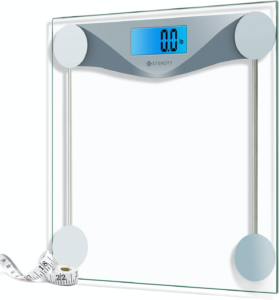
Etekticy’s Digital Weight Scale is an Amazon best-seller and provides readings for 13 key compositions, including visceral fat, muscle mass, bone mass, body water, BMI, and overall body fat.
This sleek, 6mm-thick indium tin oxide coated scale, allows for precise measurements thanks to its built-in four electrodes. It also allows for unlimited users to create profiles that sync with your favorite health apps such as FitBit, Apple Health and Google Fit. For these reasons, it’s our #1 pick.
2. RENPHO Body Fat Scale

Compatible with fitness apps and Bluetooth 4.0, the RENPHO Body Fat Scale provides measurements for up to 13 different key compositions.
It uses Bio-electrical Impedance Analysis to calculate body metrics, with four high-precision electrode sensors measuring in increments of 0.2 lbs.
3. FITINDEX Bluetooth Body Fat Scale
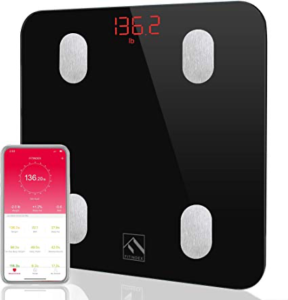
This Bluetooth scale allows an unlimited number of users to track their health data with their favorite apps such as Apple Health, FitBit and Google Fit.
Fitindex also allows you to connect with your phone and log up to 13 different body composition readings, including body fat, muscle mass, bone mass, and water percentage.
4. Bveiugn Digital Body Fat Scale
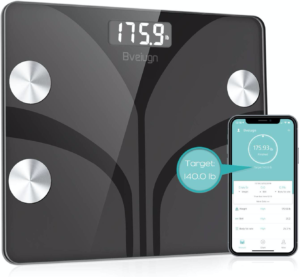
With 11 different body composition readings, the Bveiugn Digital Body Fat Scale comes with a free Fitdays app where you can manage your health data and track your progress.
This scale is made from tempered glass and uses Bio-electrical Impedance Analysis (BIA) to provide precise measurements for up to 24 users.
5. REDOVER Bluetooth Body Fat Scale
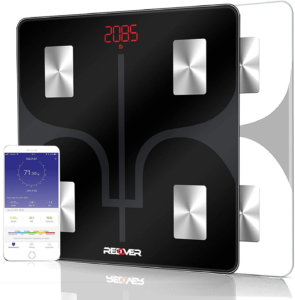
Redover’s Bluetooth Body Fat Scale allows you to precisely measure 13 different health indicators including body fat, weight and BMI. It comes with a scannable QR code so that you can use and sync your data with their Feelfit app.
REDOVER also provides a five-year warranty and lifetime customer support.
6. Pohl Schmitt Body Fat Scale
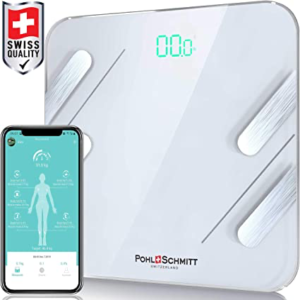
Compatible with an included free app that you can download from the Google Play Store or Apple Store, this Swiss-quality scale offers 13 different health measurements in pounds, kilograms, or stones.
Pohl Schmitt uses Bio-electrical Impedance Analysis (BIA) to accurately measure your body weight, body fat, body water, muscle mass, BMR, and more.
7. Runcobo Body Fat Scale
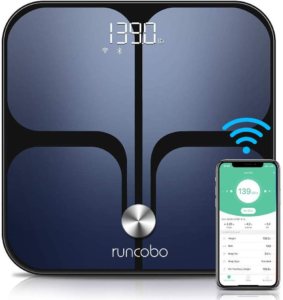
Although on the more expensive side, the Runcobo body fat scale provides accurate measurements for more than 14 different health indicators including water and body fat percentage, bone mass, muscle mass, BMR, BMI, and skeletal muscle mass.
It’s compatible with various health apps including Runcobo, Apple Health, Google Fit, and FitBit.
8. Yoleo Smart Scale

Yoleo’s Smart Scale tracks 13 total health indicators including weight, BMI, body fat, body water, skeletal muscle, BMR, fat-free body weight, subcutaneous fat, visceral fat, muscle mass, bone mass, protein, and metabolic age.
The Yoleo FEELFIT app allows you to weight yourself anytime and syncs your data to health apps like FitBit, Google Fit, or Apple Health.
9. Innotech Smart Bluetooth Scale

The included Innotech app tracks 9 essential health indicators and can sync data with Google Fit, FitBit, and Apple Health apps.
Innotech’s Smart Bluetooth Scale has large LED display with a durable, tempered glass design that will provide years of accurate measurements.
10. Misiki Smart Scale

Misiki’s Smart Scale supports up to 24 users and can accurately track 13 different health indicators via the free Fitdays app.
While the default mode is in pounds, you can change the scale’s settings to kilograms with a button on the back. It also includes a baby mode, which can help asses your baby’s health.
How We Ranked
Most of the scales we reviewed and ranked above provide tracking of ten or more different health metrics. This was important, because it allowed users to get a full picture of their health instead of just one aspect. The Runcobo Body Fat Scale goes above and beyond tracking 14 health metrics, all while being compatible with several different health apps so you can better meet your fitness goals.
We also looked for body fat scales that can support multiple users at once, like the Bveiugn Digital Body Fat Scale, which can track up to 24 separate profiles. This makes it a great choice if you want something for your gym or have several family members that want to share the scale. The Etekticy’s Digital Weight Scale is another excellent body fat scale that lets you make unlimited profiles – which is why it ranked so high on our list.
Lastly, we required our body fat scales to have automatic wireless or Bluetooth syncing capabilities. The best scales, like Renpho, worked with Fitbit, Google Fit, and Apple Health apps to provide effortless and automatic tracking. We chose just a few few body fat scales that worked with just the in-house app, due to the impracticality.
Benefits
Body fat scales help you keep track of your weight. Body fat scales are capable of measuring and tracking your weight in pounds, stones, or kilograms. Knowing your weight is a first step in calculating other health metrics such as your calories and how much protein your body needs on a daily basis.
Body fat scales can be used to estimate body water. A 1996 scientific panel, made up of 13 nonfederal members representing fields like nutrition, surgery, pediatrics, public health, alongside an additional 20 experts in nutrition concluded that BIA measurement used by body fat scales was a reliable method for measuring the above aspects.
They determined that it could be a useful tool for relatively healthy individuals and those with chronic but mild conditions like mild to moderate obesity and diabetes (1).
Body fat scales help assess body fat percentage. Body fat scales can help track your body fat percentage, which can help determine what lifestyle interventions, if any, are needed.
However, this number should be taken with a grain of salt because Bio-electrical Impedance, which is the standard method of testing across most body fat scales, can be fairly inaccurate. This is especially true for special populations like athletes, children, and pregnant women.
Body fat scales monitor the different types of fat. There are two primary types of fat: subcutaneous fat and visceral fat. Subcutaneous fat lies beneath the skin and is relatively harmless, with some research showing that it can even protect against disease. A 2009 study showed that abdominal subcutaneous fat was not associated with linear increases in traditional risk factors associated with obesity (2).
Visceral fat, on the other hand, can be quite deadly since it surrounds your organs. Linked to cardiovascular disease, asthma, breast cancer, colorectal cancer, and dementia, some studies suggest that visceral fat plays a role in cholesterol production and in the release of other biochemicals that can be damaging to overall health. Using body fat scales and knowing your percentage of subcutaneous fat and visceral fat can help you more closely assess your levels of disease risk.
Body fat scales help you measure your skeletal muscle and fat-free body weight. If you’re focusing on building muscle or on leaning down without losing muscle mass, tracking your skeletal muscle is crucial. Skeletal muscle is the muscle that facilitates movement and is only one component of your fat-free mass.
Increasing your skeletal muscle mass has a variety of benefits, including improved bone density, a stronger metabolism, improved blood sugar management, greater endurance, more strength, and decreased risk of injury.
Skeletal muscle tracking can also alert you to muscle loss, which may be the result of poor nutrition or excess dieting. Inadequate caloric intake can also cause your body to lose muscle mass, which damages your metabolism in the long run. Fat-free mass helps to indicate if you’re experiencing bone loss. It is also helpful for menstruating women who are tracking changes in their cycle (3).
Body fat scales help monitor bone mass. Bone mass is essentially the weight and density of your entire skeletal system. Monitoring your bones mass helps to assess your skeletal health and alert you to lifestyle changes you may need to make to help prevent or manage osteoporosis.
One 2006 study with several clinical trials showed that bone measurement and tracking could be useful for reducing fracture risk and for treating certain types of bone maladies (4).
Body fat scales may be able to measure your metabolic age. Your metabolic age is impacted by a variety of factors, including muscle mass and total lean mass. It’s calculated by comparing your BMR to that of your age group and can give you an idea of how efficiently your body functions for your age.
It should be noted that metabolic age does not take into account mental health, emotional health, career satisfaction, or relational stability, all of which play a significant role in overall longevity and quality of life.
Body fat scales can calculate your basal metabolic rate. Your BMR, or basal metabolic rate, is how much energy your body uses to maintain vital functions when at complete rest. BMR is also an important number that can help calculate accurate caloric requirements. However, a body fat scale probably won’t account for genetic abnormalities or health conditions such as hypothyroidism or hyperthyroidism – both of which impact your BMR (5).
Studies show that eating below your BMR caloric requirements can slow your metabolism, damage your metabolism, cause fatigue, worsen pre-existing health conditions, lower immunity, weaken your bones, reduce fertility, and cause nutritional deficiencies (6).
One 2013 meta-analysis, combining 47 studies with enough detail for meta-regression equations, showed that BMR formulas were effective at determining overall health for large populations and for calculating good weight loss/nutritional strategies (7).
Body fat scales can provide accurate readings while saving money. A 2013 study involving 89 African-American and white subjects showed that BIA body fat scales continually demonstrated acceptable accuracy for estimating body fat percentage. This was compared to more expensive weight measurement methods like dual-energy x-ray absorptiometry (8).
Body fat scales are accurate when you use them consistently over the long term. A 2007 study focusing on 115 male and female subjects from northern Mexico between 20 and 50 years of age found that BIA body fat scales were accurate and free of bias when the results were compared against everyone in the group. Exact metrics/results could vary, but the measurement technique provided valuable evidence for general group trends (9).
Side Effects
Body fat scales are not always accurate and can give an incomplete picture of your health. Body fat scales can’t determine where your body naturally stores fat or where certain trouble spots might arise, like around your heart for other major organs. A 2009 study with 38 male and 14 female children showed that body fat scales were inadequate when applied to individual testing needs. Doctors had to use other testing methods to determine adequate health recommendations for each person (10).
Body fat scales can decrease interoceptive awareness. Interoceptive awareness can be defined as the ability to know what your body is feeling from the inside. Since eating disorders, disordered eating, and diets often encourage a focus on external measurements like calories, macros, and weight, body fat scales can be a tool in supporting disorder behaviors and distracting patients from increased interoceptive awareness (11).
Body fat scales can consume someone’s sense of self. Some individuals who monitor their weight and body fat too closely may come to associate the scale number with their own self-worth. Instead, body fat scales should be used as a neutral tool for assessing where your body feels at its best, monitoring the growth of muscle mass, and providing accurate data over the course of an athletic journey.
Body fat scales are often inaccurate when used with athletes. A 1998 study involving 15 athletic subjects between the ages of 19 and 56 found that drinking small amounts of water created sweeping changes in the results gathered by body fat scales. Sweating, even mildly, also caused these scale inaccuracies. While modern scales may be more accurate, this still indicates that the devices are susceptible to misreading (11).
Body fat scales cannot be used to adequately track long-term body composition for endurance trainers. A 1997 study involving several endurance athletes showed that BIA measurements were not able to competently track body composition changes over 12 weeks. While BIA measurement may still be able to give you a general range of your body fat percentage over time, it’s not adequate for figuring out how your body fat develops as you train (12).
Recommended Usage
Body fat scales can be used daily if needed. However, they should be used under similar circumstances since this can affect the scale’s ratings. The best time to use a body fat scale is in the morning, when you wake up, before eating or drinking anything, and ideally naked.
You should also avoid weighing yourself within 24 hours of drinking lots of alcohol as this can affect your water retention and body weight. Avoid weighing yourself after exercising excessively as you likely will have sweat out tons of water beforehand, affecting the results.
It’s important to set your body fat scale on a tiled or wooden floor with an even surface. Avoid placing the scale on a carpet as the fibers can conduct electricity and mess with the readings. You may also want to weigh yourself in a room with a relatively even temperature. Make certain that the footpads for the body fat scale are clean before stepping on; dirt or debris can interfere with the electrical current and skew the results.
FAQ
How long does a body fat scale last? If you take care of it, body fat scales can last up to a decade. However, with new technology coming out every few years, you should consider upgrading your body fat scale every five years or so.
How can you tell if a body fat scale is inaccurate? It is unlikely you will be able to tell if a body fat scale is inaccurate unless you compare it to other scales. In general, most body fat scales can be 3-4% off, so don’t get alarmed if your readings are different on the gym scale then at home.
The gold standard of measuring body fat is DEXA, and you should compare your at-home body fat scale results to the results of the DEXA scan to see how accurate it is.
How does a body fat scale know which user is being weighed? A body fat scale normally matches readings with an accompanying app, where a user has set up their own profile. Once the user steps on the scale and begins tracking their stats, the scale’s sensors and algorithms can identify the user based on their personal metrics.
When is the best time to weigh yourself on a body fat scale? Just like any other scale, it is best to weigh yourself at the same time every day for the most accurate measurement and to track trends. Most people weigh themselves in the morning after fasting overnight. It would be best if you used the same clothes every time you weigh yourself to prevent discrepancies.
Can low battery affect body fat scale measuring? Yes, low battery levels can certainly impact the accuracy of body fat scales.
How does a body fat scale measure metrics? Most body fat scales use bioelectrical impedance analysis (BIA) to measure body fat, muscle tone, bone density, and BMI. When you step on the scale, a signal that can detect electricity is sent through your legs and across your pelvis, measuring body fat resistance.
Muscles, bones, blood vessels easily conduct electricity, whereas body fat has limited electrical conductivity. A weak electrical current determines the amount of fat tissue, and this data is combined with your profile to create your body composition numbers.
How much current passes through your body during a test? Body fat scales use an imperceptible amount of current to perform their testing. This is usually around 0.001 amps, which should be impossible to feel in your body/brain.
How accurate are body fat scales? Even the best body fat scales will not be able to give you a perfect reading for your body fat percentage. On average, you can expect body fat scales to be off by about 3% to 4%. However, this margin for error can somewhat be compensated for by taking multiple readings over several months to narrow down a body fat range where your true body fat percentage likely lies. It also helps to conduct your body fat tests under near-identical conditions every time.
Do body fat scales tell me how healthy I am? Body fat scales are tools that can provide detailed insight into your overall body composition, which can help you understand your metabolism, caloric needs, and risk factors for chronic diseases. However, they do not measure social or environmental health metrics, both of which are huge factors in the development of physical and mental illnesses (13).
What factors play roles in shaping an individual’s health? Some factors that shape an individual’s health include environmental issues such as air pollution, proximity to toxic sites, the “built environment,” land-use patterns, transportation systems, and design and urban planning features.
Nutrition factors include food availability, food advertising, walkability, and the density of alcoholic beverage retail outlets in a particular area. Social factors include social participation, social cohesion, violence, crime rates, social norms in shaping health-related behaviors, the stability of households and families, and social support. These factors cannot be measured by scales, but they may contribute to and affect the numbers you see on the scale (14).
Can other users see my data on a body fat scale? No, other users will not have access to your data unless you add their profile to your app.
Why are body fat measurements better than BMI? Body fat measurements provide a more detailed, accurate picture of your body’s overall composition. Understanding the difference between body mass index (your weight relative to your height), subcutaneous fat, and visceral fat can help you more accurately assess your particular health state and needs.
For instance, an Olympic rower may be classified as overweight or even obese according to the BMI, given their robust bone structure and muscular development. Conversely, a slight, normal-weight individual may have unhealthy levels of visceral fat around their internal organs.
Why do body fat scales use Bio-electrical Impedance Analysis (BIA)? Bio-electrical Impedance Analysis (BIA) is a nonintrusive, low-cost way to measure and calculate a variety of body composition metrics (15).
Impedance is the obstruction to electrical current flow. Therefore, bio-electrical impedance is the resistance to an electrical flow provided by different types of body mass: bone, muscle, subcutaneous fat, visceral fat, and water.
How do body fat scales perform a BIA test? To accurately perform BIA, a scale must possess high-sensitivity electrodes with carefully calculated currents. Algorithms assess the body’s resistance to these currents and use the level of resistance in order to calculate the types and amounts of body mass present.
I’m an intuitive eater, is it okay to use a body fat scale? As long as a body fat scale does not trigger a relapse into disordered eating behaviors, it can be used to benefit your health and actually increase interoceptive awareness. You can monitor gains in muscle mass and observe how gradual lifestyle changes impact your well-being.
Can people with a pacemaker use a body fat scale? Anyone with a pacemaker or implanted medical device should not use a body fat scale because it uses an electrical current to analyze metrics.
What is the most important health metric on a body fat scale? The most important health metrics on a body fat scale are visceral body fat, muscle mass, bone mass, and water weight. These are the most important numbers because they present you with an accurate picture of your metabolism, skeletal health, and disease risk. Other important factors to consider are mental health and social and environmental health factors, as these play a huge role in determining longevity and overall wellness (16).
What is a healthy body fat percentage? There is no single perfect healthy body fat number for everyone, as the ideal ratio depends on sex, genetics, health factors, metabolism, and activity level. The American Council on Exercise (ACE) provides a body fat chart that breaks down the ideal body fat ratio for men and women based on their fitness levels and other metrics.
How much body fat do women need? According to the American Council on Exercise (ACE), women who have 24% or less body fat are considered to be physically fit and healthy. Anything over that 32% is considered obese and unhealthy.
How much body fat do men need? According to the American Council on Exercise (ACE), men who have more than 25% body fat are considered overweight and unhealthy. More than 30% is considered obese. To be physically fit and healthy, less than 18% is required for men.
Men generally have less body fat than women because of their physiques and hormones. On average, men tend to have higher metabolisms than women, meaning they convert stored fat into energy more efficiently. Men also store less body fat than women in general, meaning it’s harder for them to gain weight even if they don’t eat particularly healthily.
Is it possible to have too little body fat? Yes, it is possible to have too little body fat. If you don’t have enough body fat, you tend to have a lower body temperature and also run the risk of certain musculoskeletal problems.
Women, in particular, need a higher average percentage of body fat to prevent osteoporosis and other illnesses or disorders. Low body fat percentages can also cause hormonal imbalances, especially in women. This can lead to loss of menstruation or eating disorders, which come with their own health issues.
What are other ways to measure body fat beyond a body fat scale? DEXA, or dual-energy x-ray absorptiometry, is an extremely reliable and precise body fat measuring tool that bases its measurements on three components: fat, muscle, and bone. It can even detect fat and muscle distribution throughout the entire body, but tends to be very expensive and requires that individuals visit a medical center or research facility.
Hydrostatic weighing is also very accurate but can provide strange results. Subjects must expel all the oxygen in their lungs while being submerged in a tank of water. If any oxygen left in the lungs, it can negatively skew results. The tank is also expensive and is usually only used in research studies or at hospitals.
Calipers are another inexpensive and home use body measurement technique. Skinfold calipers measure the thickness of your skin with the underlying layer of fat and allow you to extrapolate a general fat distribution throughout your entire body, along with a total percentage. Without experience, they are often uncomfortable and difficult to use.
Near-infrared measurement checks tissue composition across your body. It’s fast and relatively inexpensive, but it also comes with a high degree of error if you are either very lean or obese.
Why does body fat percentage fluctuate on a body fat scale? Body fat percentages can fluctuate based on hormone cycles and even current hydration levels.
What are the most important factors to consider when buying a body fat scale? For starters, the body fat scale should provide data on several different health metrics, not just body fat. You should also look at what health apps the scale can sync with to track your data. Ideally, it should sync automatically with Apple health, my fitness pal, and Google health.
While some scales can support multiple users, it’s not necessary unless you will be having multiple people religiously using the same scale to track their metrics. The scale should also have high-quality electrodes to perform an accurate BIA assessment.
What day of the week is the best to use a body fat scale? Many researchers agree that Wednesday is the optimal day to measure your self on a body fat scale. This is because it is far enough away from the weekend to avoid excess water retention from salt, sugar, and acohol. Excess water retention plays a major role in skewing body fat results, especially when using a BIA scale.
Why are body fat scales better than simple weight scales? Body fat scales are better at measuring changes in body composition, which a better indicator of overall health than just weight. This is because a person could be losing body fat but gaining muscle, causing the weight to remain stable. Without a body at scale, persons in this scenario may get discouraged at not seeing the scale move, which may cause them to give up – even though they are actually making progress.
How do body fat scales work? Body fat scales normally work by sending an electrical current through your body and measuring resistance. Body fat scales provide an estimated body fat percentage based on how long it takes for the electrical current to travel.
Why do body fat scales provide better health assessments than weight scales? Body fat scales provide a better health assessment that standard bathroom scales because they go beyond BMI. BMI can be a reliable indicator of your overall health but is often inaccurate in people who have muscle mass like athletes and bodybuilders.
BMI is also inaccurate in persons of Asain descent. Body fat is a better indicator of overall health because it tends to be more associated with disease and longevity.
What are the three types of fat that body scales can measure? Body fat scales can measure up to 3 types of fat: subcutaneous, visceral and brown. Subcutaneous fat is the pinchable fat that sits around your hips. It can provide a great deal of health benefits if there isn’t an excessive amount.
Visceral fat sits inside the abdominal cavity, lining the vital organs and tends to be associated with disease and health risks. Brown fat is especially abundant in babies and helps the body burn calories and stay warm. Due to the limited amount found in adults, brown fat is not often measured in body fat scales.
Related Articles
Recap
Body fat scales provide you with a simple and efficient way to monitor body fat, weight, and BMI to understand your health on a deeper level.
Most body fat scales today integrate with popular apps that will help track changes over time and help you adjust course to hit your goals faster.
For FitBug’s #1 recommended body fat scale, here.